Stories & Legends
 |
 |
 |
 |
 |
 |
 |
The Mantle of St. Brigid
Ireland’s Patron Saints are three, Patrick, Brigid and Columba. Wherever an off-shoot of the Gaelic stock takes root, in torrid clime or snow-swept regions, under the shadow of the silent palm or in the shelter of the rustling pine, the Irishman plants the standard of this tutelary three, whose story is always in his memory, and whose sanctuary is in his heart.
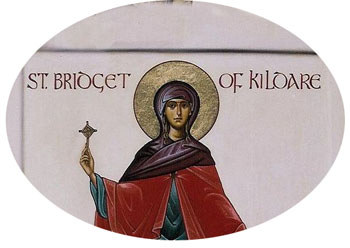 According to the order in which they are named, these saintly personages lived, loved and labored. When Patrick was called to his reward, Brigid had entered on her career; and when the Abbess of Kildare fulfilled her course, Columba was a stripling of fair promise.
According to the order in which they are named, these saintly personages lived, loved and labored. When Patrick was called to his reward, Brigid had entered on her career; and when the Abbess of Kildare fulfilled her course, Columba was a stripling of fair promise.
A popular Irish hymn in honor of St. Brigid is Gahhaim molta Bhrighde, "I sing the praises of Brigid." And well indeed are her praises sung, for the Abbess of Kildare worked many miracles and because of her holiness converted multitudes.
About the year 490, the Abbess Brigid had established her residence at Cill-dara, or Church of the Oak, in what is today the County of Kildare. At the edge of a forest in this land, a majestic oak stood out as a landmark and object of admiration to lovers of the wondrous works of God in nature.
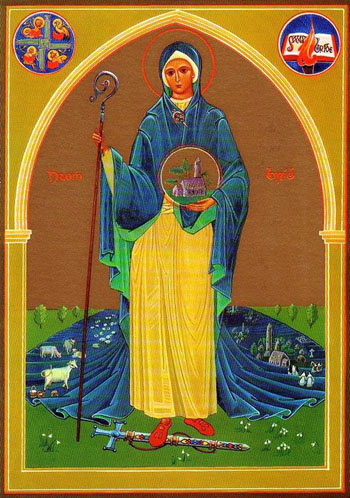
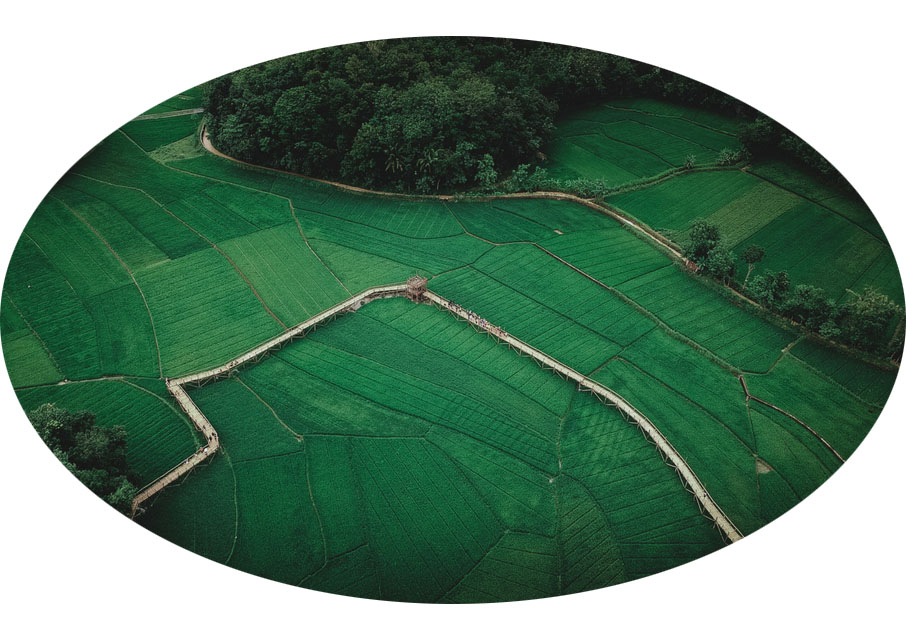 Now Brigid loved the tall oak and blessed it, and resolved to take up her abode beneath its leafy shade. And while she was wondering how she might procure the wherewithal to erect her group of monastic huts on the spot, there happened to pass by a train of 100 horses laden with wattles and peeled branches for the use of the King of Leinster, Ailihill, son of Dunlaing.
Now Brigid loved the tall oak and blessed it, and resolved to take up her abode beneath its leafy shade. And while she was wondering how she might procure the wherewithal to erect her group of monastic huts on the spot, there happened to pass by a train of 100 horses laden with wattles and peeled branches for the use of the King of Leinster, Ailihill, son of Dunlaing.
Immediately it occurred to her to ask the King to bestow on her this treasure of building materials, and she dispatched some of her companions to make the request. Ailihill, who knew of her holiness and goodness, graciously granted what was asked. And he did more, for he sent men to stake the ground and build the huts, and he paid them while they worked under Brigid’s directions.
It followed, as a matter of course, that pious women came from all parts asking to be admitted into the religious family and allowed to join in the good work undertaken for God and the people of Erin.
Accordingly, as the community increased, the cells became more numerous and the monastery widened its boundaries beyond the circuit of the great oak’s waving boughs. In like manner the few fields that at first sufficed to pasture the sheep and cows of the new foundation and grow the necessary crops, no longer answered to the needs of the establishment.
Now then, the dynasts of the adjacent territories were truly Irish in their generosity, and gave the holy Abbess whatever lands she required for tillage and grazing.
Only one of the local Princes of Kilgore, it would seem, met her request with a denial. This exceptional case gave rise to a great miracle that has been told and retold, and continues to be told to this very day.
One day the toparch stood on a rising ground overlooking the Curragh, and beside him was Brigid in her veil and flowing mantle, with four of her nuns in attendance. The great man had just declared that he did not see his way to granting the field in question to the monastery.
“Alas,” replied Brigid, “at least, then, will you give me as much ground as my mantle will cover?”
He smiled and could not say no to such a request.
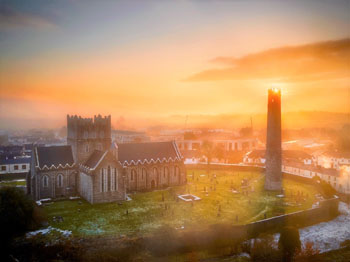 But the moment he said yes, the Abbess Mother instructed her four daughters to each take hold of an edge of their mother’s cloak. And then each sister began to walk away, swift as the wind, north, south, east and west, covering the ground with the cloak that stretched and stretched in a wondrous manner.
But the moment he said yes, the Abbess Mother instructed her four daughters to each take hold of an edge of their mother’s cloak. And then each sister began to walk away, swift as the wind, north, south, east and west, covering the ground with the cloak that stretched and stretched in a wondrous manner.
The owner of the soil, thrown into a state of consternation, implored the Abbess Brigid to call her daughters back before they had overrun the whole of Ireland. St. Brigid smiled at his instance, and called back her daughters. Then, after making some telling observations on the need to correct an avaricious disposition, she accepted from that Prince the grant of the field for which she had originally asked.
That land was readily bestowed on her with more than good will. Indeed this converted Prince became a great patron and strong devotee of St. Brigid for as long as he lived.
Gahhaim molta Bhrighde
I sing the praises of Brigid, she is dear to Ireland,
Dear for generations, we all praise her.
She is the bright torch of the Leinstermen, shining throughout the land,
The Queen of the maidens of Ireland, the Queen of women in gentleness.
Many a well and church is consecrated by the name of Brigid;
Often do we hear it still as a name for the girls of our land.
The black dark winter comes, sharp and cutting;
But on St. Brigid's day we greet the springtime of Ireland.
May God send us now, through the loving prayer of Brigid,
A bright and peaceful springtime on our beloved country;
May God give us hope on this great festival
That we may obtain graces now and Heaven beyond hereafter.

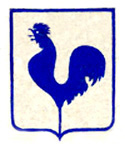

St. Brigid, Abbess of Kildare,
one of Ireland’s Triad of Saints
A popular Irish hymn in honor of St. Brigid is Gahhaim molta Bhrighde, "I sing the praises of Brigid." And well indeed are her praises sung, for the Abbess of Kildare worked many miracles and because of her holiness converted multitudes.
About the year 490, the Abbess Brigid had established her residence at Cill-dara, or Church of the Oak, in what is today the County of Kildare. At the edge of a forest in this land, a majestic oak stood out as a landmark and object of admiration to lovers of the wondrous works of God in nature.

St. Brigid’s cloak stretched over a large property in what is today County Kildare

Immediately it occurred to her to ask the King to bestow on her this treasure of building materials, and she dispatched some of her companions to make the request. Ailihill, who knew of her holiness and goodness, graciously granted what was asked. And he did more, for he sent men to stake the ground and build the huts, and he paid them while they worked under Brigid’s directions.
It followed, as a matter of course, that pious women came from all parts asking to be admitted into the religious family and allowed to join in the good work undertaken for God and the people of Erin.
Accordingly, as the community increased, the cells became more numerous and the monastery widened its boundaries beyond the circuit of the great oak’s waving boughs. In like manner the few fields that at first sufficed to pasture the sheep and cows of the new foundation and grow the necessary crops, no longer answered to the needs of the establishment.
Now then, the dynasts of the adjacent territories were truly Irish in their generosity, and gave the holy Abbess whatever lands she required for tillage and grazing.
Only one of the local Princes of Kilgore, it would seem, met her request with a denial. This exceptional case gave rise to a great miracle that has been told and retold, and continues to be told to this very day.
One day the toparch stood on a rising ground overlooking the Curragh, and beside him was Brigid in her veil and flowing mantle, with four of her nuns in attendance. The great man had just declared that he did not see his way to granting the field in question to the monastery.
“Alas,” replied Brigid, “at least, then, will you give me as much ground as my mantle will cover?”
He smiled and could not say no to such a request.

St. Brigid’s Cathedral in Kildare Town, where St. Brigid established her first church in the year 480
The owner of the soil, thrown into a state of consternation, implored the Abbess Brigid to call her daughters back before they had overrun the whole of Ireland. St. Brigid smiled at his instance, and called back her daughters. Then, after making some telling observations on the need to correct an avaricious disposition, she accepted from that Prince the grant of the field for which she had originally asked.
That land was readily bestowed on her with more than good will. Indeed this converted Prince became a great patron and strong devotee of St. Brigid for as long as he lived.
I sing the praises of Brigid, she is dear to Ireland,
Dear for generations, we all praise her.
She is the bright torch of the Leinstermen, shining throughout the land,
The Queen of the maidens of Ireland, the Queen of women in gentleness.
Many a well and church is consecrated by the name of Brigid;
Often do we hear it still as a name for the girls of our land.
The black dark winter comes, sharp and cutting;
But on St. Brigid's day we greet the springtime of Ireland.
May God send us now, through the loving prayer of Brigid,
A bright and peaceful springtime on our beloved country;
May God give us hope on this great festival
That we may obtain graces now and Heaven beyond hereafter.

Adapted from St. Brigid, Abbess of Kildare, Part II,
The Irish Monthly, Vol. 16, No 177
(March 1888), pp 163-64 by
Posted February 10, 2024
The Irish Monthly, Vol. 16, No 177
(March 1888), pp 163-64 by
Posted February 10, 2024






